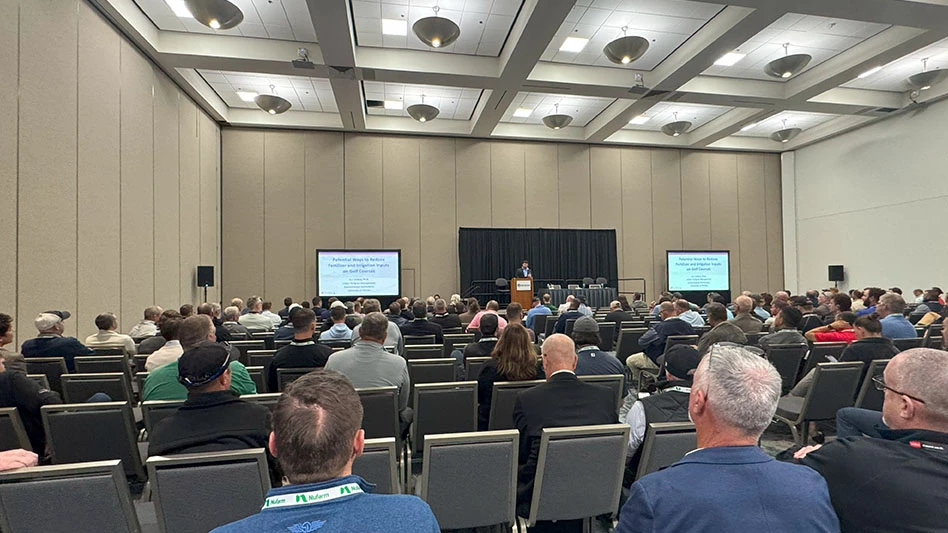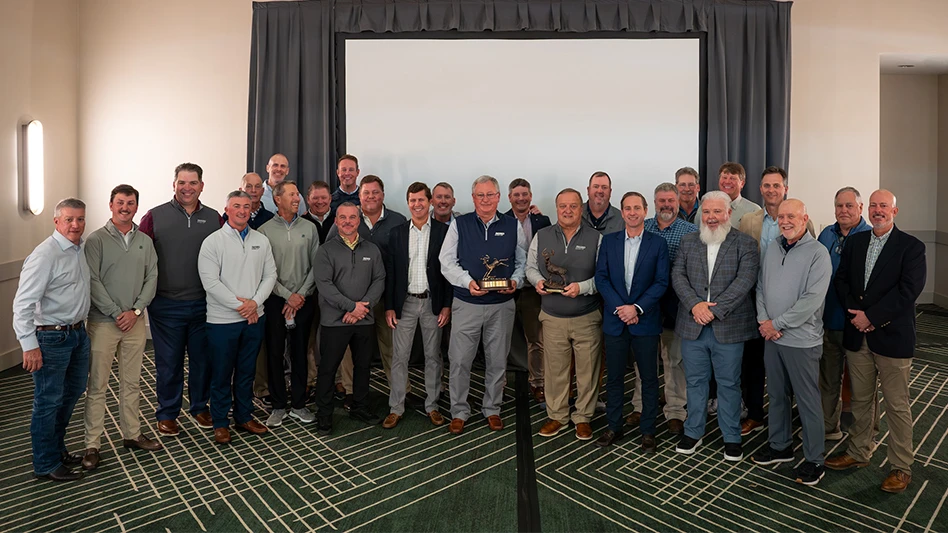
In 2019, Highland Golf and Country Club in Indianapolis, Ind., will be 100 years old. The par-70, 6,400-yard course has some rich history, having hosted the 1926 Western Open and the 1945 Women’s Western Open.
“Bobby Jones and Walter Hagen actually shook hands and made up over a year-long tiff that they had had, on our 18th green at the end of the Western Open,” says superintendent Ryan Baldwin.
Willie Park Jr. routed the course, and Bill Diddel, who was a member at an earlier location of the private club, finished it. “Bill Diddel ended up doing thousands of golf courses, mainly in the Midwest and Florida,” Baldwin says. “We were arguably his first.”
Highland has changed over the years, due to both outside and inside influences. As Indianapolis expanded, it became a downtown club. Two years ago, Baldwin oversaw a complete bunker restoration.
 One of the most recent changes has been the institution this year of Bayer’s Signature Stressgard XTRA fungicide program. Utilizing the program over the past several months, Baldwin has improved his turf’s health, while simultaneously reallocating labor and dollars and pleasing golfers.
One of the most recent changes has been the institution this year of Bayer’s Signature Stressgard XTRA fungicide program. Utilizing the program over the past several months, Baldwin has improved his turf’s health, while simultaneously reallocating labor and dollars and pleasing golfers.
Poa annua and bentgrass make up Highland’s greens, and they have not been friendly to stress over the years, says Baldwin, who became superintendent in 2006. “These are the touchiest greens I’ve ever had to manage,” he says. “It seems like they’re affected by a little bit of breeze, humidity changes — and not necessarily from a disease standpoint, per se. They’re just very touchy to environmental changes.”
This past off-season, Baldwin spoke with his Bayer representative, John Turner, about the issues with his greens. Turner gave him information about Signature Stressgard XTRA, and he decided he would try it out. “I instituted that back in for the first half of the season on half of our putting greens and was very impressed with the vigor that we had, so then moved into using that on all of our putting surfaces for the rest of the year and plan on doing the same again for this upcoming season,” he says.
When turf plants are healthy, they are able to withstand stress, Baldwin says. Upon applying Signature Stressgard XTRA, Baldwin has noticed his greens can withstand traffic better than they used to, and disease pathogens are less of an issue than they used to be. Additionally, he and his crew don’t have to hand-water as frequently as they previously did, so they are able to focus on other tasks.
The crew also applies fewer fertilizers than they used to, which saves money, Baldwin says. “I’ll probably end the year at about 1.25 pounds of nitrogen for the season, whereas three or four years ago that might have been two and a quarter,” he says.
Baldwin applies Signature Stressgard XTRA every seven days at a rate of two ounces per thousand square feet, he says. He does this instead of following the common method of applying four ounces every 14 days because he already uses his sprayer weekly for other product applications.
Over the course of the year, Baldwin has become more comfortable tank mixing the fungicide with other products, such as fertilizers and growth regulators, he says. “Initially, I was very, very cautious about what I would tank mix with it, not necessarily because of turf damage, but because of efficacy.”
Highland’s greens have built up a strong resistance to DMI fungicides, so Baldwin is excited about Bayer’s new offerings, such as Signature Stressgard XTRA. “It looks like they’re coming out with some new and improved fungicides that a guy like me can get back into my program as well,” he says. “So I’m pretty excited after talking to them more recently that It looks like their line is going to help me out quite a bit.”
Throughout the 2016 season, the program has had a positive, albeit indirect, effect on the club’s membership, Baldwin says. Because the crew is hand-watering and syringing less, members are less bothered and are able to focus their attention on the game. The crew is also able to maintain lower heights of cut and a quality topdressing program. Stresses don’t call for mowing heights to be raised, and the putting quality remains.
“My putting surfaces are my business card, and they’re my members’ newborn child,” Baldwin says. “In the long haul, even though I’m buying a premium product to put down, I’m not out with rescue applications. So I’m not increasing my overall expense to my putting surfaces. That application has a higher price, but the net benefit is a much lower cost, not only economically, but definitely in product quality, which is what we’re all going to be judged on at the end of the day.”
With healthy turf, a productive crew and a satisfied membership, Highland continues to build upon its legacy, through its centennial and beyond.
Patrick Williams is a Cleveland-based turf writer and frequent GCI contributor
“Bobby Jones and Walter Hagen actually shook hands and made up over a year-long tiff that they had had, on our 18th green at the end of the Western Open,” says superintendent Ryan Baldwin.
Willie Park Jr. routed the course, and Bill Diddel, who was a member at an earlier location of the private club, finished it. “Bill Diddel ended up doing thousands of golf courses, mainly in the Midwest and Florida,” Baldwin says. “We were arguably his first.”
Highland has changed over the years, due to both outside and inside influences. As Indianapolis expanded, it became a downtown club. Two years ago, Baldwin oversaw a complete bunker restoration.
 One of the most recent changes has been the institution this year of Bayer’s Signature Stressgard XTRA fungicide program. Utilizing the program over the past several months, Baldwin has improved his turf’s health, while simultaneously reallocating labor and dollars and pleasing golfers.
One of the most recent changes has been the institution this year of Bayer’s Signature Stressgard XTRA fungicide program. Utilizing the program over the past several months, Baldwin has improved his turf’s health, while simultaneously reallocating labor and dollars and pleasing golfers.Poa annua and bentgrass make up Highland’s greens, and they have not been friendly to stress over the years, says Baldwin, who became superintendent in 2006. “These are the touchiest greens I’ve ever had to manage,” he says. “It seems like they’re affected by a little bit of breeze, humidity changes — and not necessarily from a disease standpoint, per se. They’re just very touchy to environmental changes.”
This past off-season, Baldwin spoke with his Bayer representative, John Turner, about the issues with his greens. Turner gave him information about Signature Stressgard XTRA, and he decided he would try it out. “I instituted that back in for the first half of the season on half of our putting greens and was very impressed with the vigor that we had, so then moved into using that on all of our putting surfaces for the rest of the year and plan on doing the same again for this upcoming season,” he says.
When turf plants are healthy, they are able to withstand stress, Baldwin says. Upon applying Signature Stressgard XTRA, Baldwin has noticed his greens can withstand traffic better than they used to, and disease pathogens are less of an issue than they used to be. Additionally, he and his crew don’t have to hand-water as frequently as they previously did, so they are able to focus on other tasks.
The crew also applies fewer fertilizers than they used to, which saves money, Baldwin says. “I’ll probably end the year at about 1.25 pounds of nitrogen for the season, whereas three or four years ago that might have been two and a quarter,” he says.
Baldwin applies Signature Stressgard XTRA every seven days at a rate of two ounces per thousand square feet, he says. He does this instead of following the common method of applying four ounces every 14 days because he already uses his sprayer weekly for other product applications.
Over the course of the year, Baldwin has become more comfortable tank mixing the fungicide with other products, such as fertilizers and growth regulators, he says. “Initially, I was very, very cautious about what I would tank mix with it, not necessarily because of turf damage, but because of efficacy.”
Highland’s greens have built up a strong resistance to DMI fungicides, so Baldwin is excited about Bayer’s new offerings, such as Signature Stressgard XTRA. “It looks like they’re coming out with some new and improved fungicides that a guy like me can get back into my program as well,” he says. “So I’m pretty excited after talking to them more recently that It looks like their line is going to help me out quite a bit.”
Throughout the 2016 season, the program has had a positive, albeit indirect, effect on the club’s membership, Baldwin says. Because the crew is hand-watering and syringing less, members are less bothered and are able to focus their attention on the game. The crew is also able to maintain lower heights of cut and a quality topdressing program. Stresses don’t call for mowing heights to be raised, and the putting quality remains.
“My putting surfaces are my business card, and they’re my members’ newborn child,” Baldwin says. “In the long haul, even though I’m buying a premium product to put down, I’m not out with rescue applications. So I’m not increasing my overall expense to my putting surfaces. That application has a higher price, but the net benefit is a much lower cost, not only economically, but definitely in product quality, which is what we’re all going to be judged on at the end of the day.”
With healthy turf, a productive crew and a satisfied membership, Highland continues to build upon its legacy, through its centennial and beyond.
Patrick Williams is a Cleveland-based turf writer and frequent GCI contributor
Get curated news on YOUR industry.
Enter your email to receive our newsletters.Loading...
Latest from Golf Course Industry
- Ace of a decision
- Idaho course joins Concert Golf portfolio
- Central Turf & Irrigation Supply celebrates 35 years in the industry
- Musser Turfgrass Foundation honors University of Georgia researcher
- Riviera CC donates $1 million for fire relief
- Bernhard and Company names North American Distributor of the Year
- Golf course architecture firms merge to create Smyers Coyne Craig
- A week of success





